FIN4001 Finance Report: Investment, Governance & Budgeting Analysis
VerifiedAdded on 2023/06/12
|15
|3109
|299
Report
AI Summary
This report provides a comprehensive analysis of key finance concepts, starting with a capital budgeting exercise for CyberScore Plc, evaluating two mutually exclusive projects using NPV, WACC, and payback period methods to recommend the optimal investment. It further explores the relationship between corporate governance and corporate social responsibility, highlighting their similarities and differences, and outlines the performance criteria for non-executive directors. Finally, the report discusses the advantages and limitations of traditional budgeting systems, including their role in control, organizational culture, planning, and decentralization, while also addressing inefficiencies and the time-consuming nature of budget preparation. This document is available on Desklib, a platform offering a range of study tools and resources for students.

Running head: INTRODUCTION TO FINANCE
Introduction to Finance
Name of the Student:
Name of the University:
Author’s Note:
Introduction to Finance
Name of the Student:
Name of the University:
Author’s Note:
Paraphrase This Document
Need a fresh take? Get an instant paraphrase of this document with our AI Paraphraser
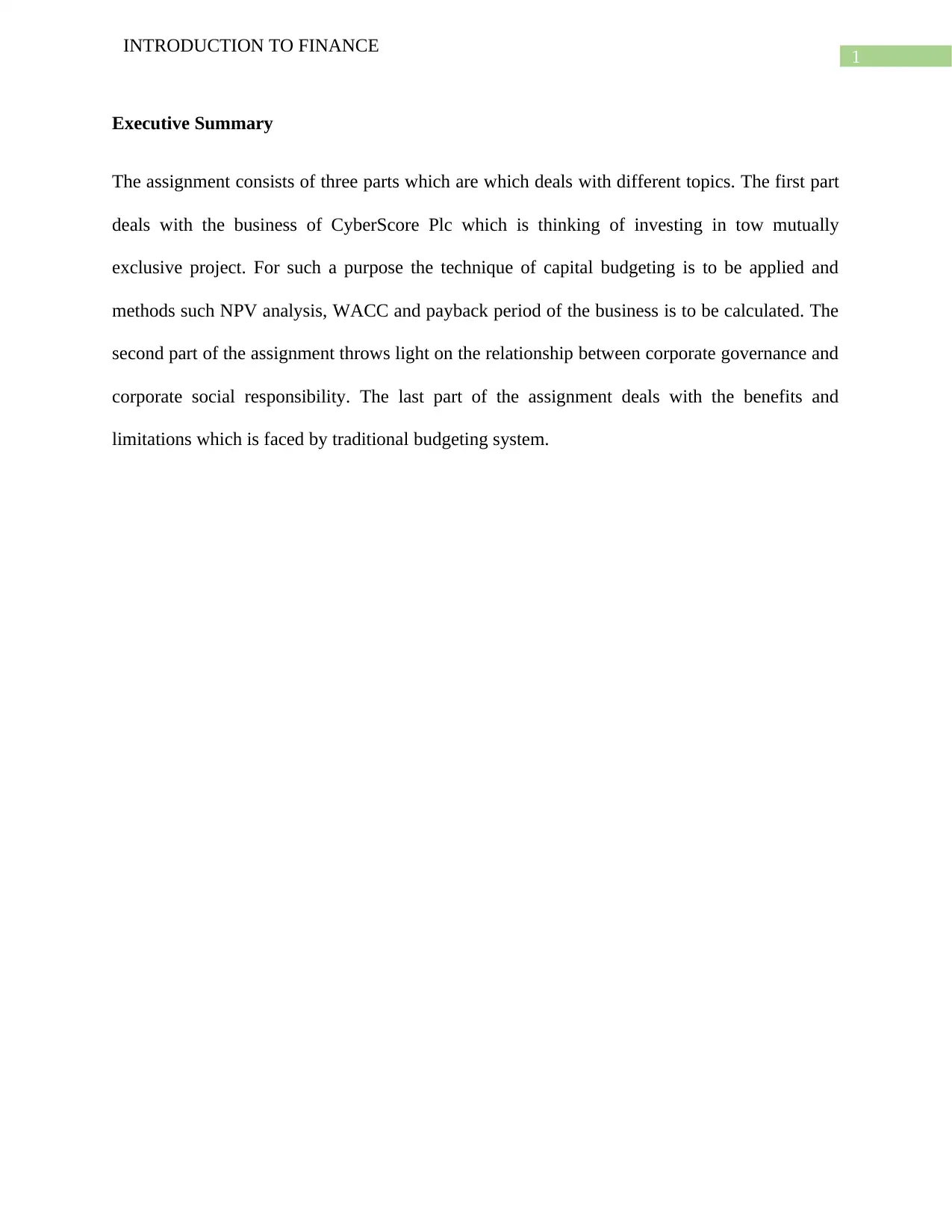
1
INTRODUCTION TO FINANCE
Executive Summary
The assignment consists of three parts which are which deals with different topics. The first part
deals with the business of CyberScore Plc which is thinking of investing in tow mutually
exclusive project. For such a purpose the technique of capital budgeting is to be applied and
methods such NPV analysis, WACC and payback period of the business is to be calculated. The
second part of the assignment throws light on the relationship between corporate governance and
corporate social responsibility. The last part of the assignment deals with the benefits and
limitations which is faced by traditional budgeting system.
INTRODUCTION TO FINANCE
Executive Summary
The assignment consists of three parts which are which deals with different topics. The first part
deals with the business of CyberScore Plc which is thinking of investing in tow mutually
exclusive project. For such a purpose the technique of capital budgeting is to be applied and
methods such NPV analysis, WACC and payback period of the business is to be calculated. The
second part of the assignment throws light on the relationship between corporate governance and
corporate social responsibility. The last part of the assignment deals with the benefits and
limitations which is faced by traditional budgeting system.

2
INTRODUCTION TO FINANCE
Table of Contents
Answer to Question 1......................................................................................................................3
Capital Budgeting and Weighted Average Cost of Capital.........................................................3
Requirement (a)...........................................................................................................................3
Requirement (b)...........................................................................................................................3
Requirement (c)...........................................................................................................................4
Requirement (d)...........................................................................................................................4
Requirement (e)...........................................................................................................................5
Answer to Question 2......................................................................................................................6
Relation Between Corporate Governance and Corporate Social Responsibility.........................6
Performance Criteria of Non-Executive Director........................................................................7
Answer to Question 3......................................................................................................................8
Advantages of Traditional Budgeting..........................................................................................8
Limitations of Traditional Budgeting System...........................................................................10
Reference.......................................................................................................................................13
INTRODUCTION TO FINANCE
Table of Contents
Answer to Question 1......................................................................................................................3
Capital Budgeting and Weighted Average Cost of Capital.........................................................3
Requirement (a)...........................................................................................................................3
Requirement (b)...........................................................................................................................3
Requirement (c)...........................................................................................................................4
Requirement (d)...........................................................................................................................4
Requirement (e)...........................................................................................................................5
Answer to Question 2......................................................................................................................6
Relation Between Corporate Governance and Corporate Social Responsibility.........................6
Performance Criteria of Non-Executive Director........................................................................7
Answer to Question 3......................................................................................................................8
Advantages of Traditional Budgeting..........................................................................................8
Limitations of Traditional Budgeting System...........................................................................10
Reference.......................................................................................................................................13
⊘ This is a preview!⊘
Do you want full access?
Subscribe today to unlock all pages.

Trusted by 1+ million students worldwide
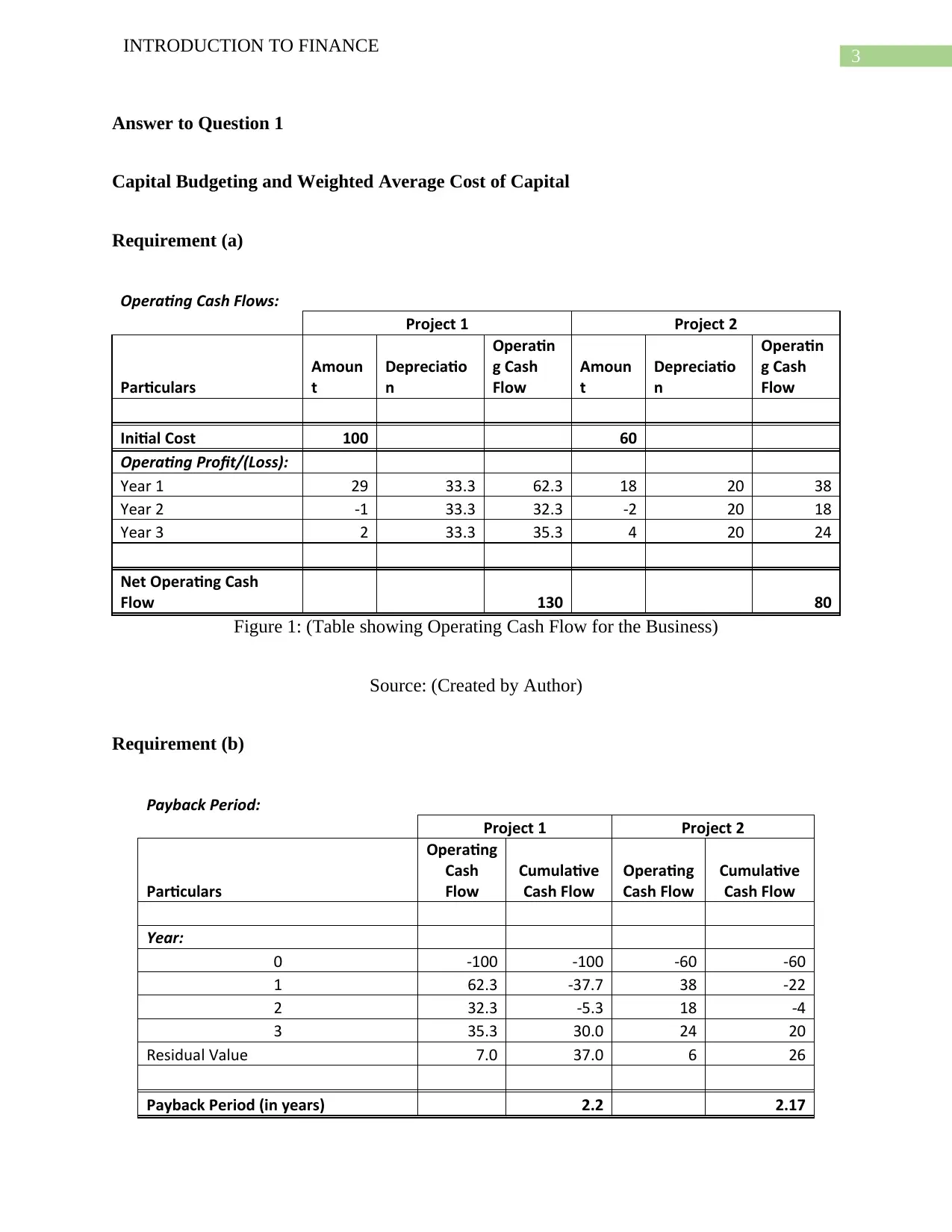
3
INTRODUCTION TO FINANCE
Answer to Question 1
Capital Budgeting and Weighted Average Cost of Capital
Requirement (a)
Operating Cash Flows:
Project 1 Project 2
Particulars
Amoun
t
Depreciatio
n
Operatin
g Cash
Flow
Amoun
t
Depreciatio
n
Operatin
g Cash
Flow
Initial Cost 100 60
Operating Profit/(Loss):
Year 1 29 33.3 62.3 18 20 38
Year 2 -1 33.3 32.3 -2 20 18
Year 3 2 33.3 35.3 4 20 24
Net Operating Cash
Flow 130 80
Figure 1: (Table showing Operating Cash Flow for the Business)
Source: (Created by Author)
Requirement (b)
Payback Period:
Project 1 Project 2
Particulars
Operating
Cash
Flow
Cumulative
Cash Flow
Operating
Cash Flow
Cumulative
Cash Flow
Year:
0 -100 -100 -60 -60
1 62.3 -37.7 38 -22
2 32.3 -5.3 18 -4
3 35.3 30.0 24 20
Residual Value 7.0 37.0 6 26
Payback Period (in years) 2.2 2.17
INTRODUCTION TO FINANCE
Answer to Question 1
Capital Budgeting and Weighted Average Cost of Capital
Requirement (a)
Operating Cash Flows:
Project 1 Project 2
Particulars
Amoun
t
Depreciatio
n
Operatin
g Cash
Flow
Amoun
t
Depreciatio
n
Operatin
g Cash
Flow
Initial Cost 100 60
Operating Profit/(Loss):
Year 1 29 33.3 62.3 18 20 38
Year 2 -1 33.3 32.3 -2 20 18
Year 3 2 33.3 35.3 4 20 24
Net Operating Cash
Flow 130 80
Figure 1: (Table showing Operating Cash Flow for the Business)
Source: (Created by Author)
Requirement (b)
Payback Period:
Project 1 Project 2
Particulars
Operating
Cash
Flow
Cumulative
Cash Flow
Operating
Cash Flow
Cumulative
Cash Flow
Year:
0 -100 -100 -60 -60
1 62.3 -37.7 38 -22
2 32.3 -5.3 18 -4
3 35.3 30.0 24 20
Residual Value 7.0 37.0 6 26
Payback Period (in years) 2.2 2.17
Paraphrase This Document
Need a fresh take? Get an instant paraphrase of this document with our AI Paraphraser

4
INTRODUCTION TO FINANCE
Figure 2: (Table showing Computation of Payback Period)
Source: (Created by Author)
Requirement (c)
WACC:
Particulars Weightage Return Rate
Weighted
Return
Rate
Equity 50% 9% 4.500%
Debt 50% 7% 3.500%
Total 8.000%
Add: Risk Premium 2%
Weighted Average Cost of Capital 10.000%
Figure 3: (Table showing Weighted Average Cost of Capital for the Business)
Source: (Created by Author)
Requirement (d)
Net Present Value:
Year
Particulars 0 1 2 3
Project 1:
Initial Cost -100
Operating Cash Flow 62.33 32.33 35.33
Residual Value 7.00
Net Cash Flow -100 62.33 32.33 42.33
Discount Rate 10.00% 10.00% 10.00% 10.00%
Discounted Cash Flow -100.0 56.7 26.7 31.8
Net Present Value 15.2
INTRODUCTION TO FINANCE
Figure 2: (Table showing Computation of Payback Period)
Source: (Created by Author)
Requirement (c)
WACC:
Particulars Weightage Return Rate
Weighted
Return
Rate
Equity 50% 9% 4.500%
Debt 50% 7% 3.500%
Total 8.000%
Add: Risk Premium 2%
Weighted Average Cost of Capital 10.000%
Figure 3: (Table showing Weighted Average Cost of Capital for the Business)
Source: (Created by Author)
Requirement (d)
Net Present Value:
Year
Particulars 0 1 2 3
Project 1:
Initial Cost -100
Operating Cash Flow 62.33 32.33 35.33
Residual Value 7.00
Net Cash Flow -100 62.33 32.33 42.33
Discount Rate 10.00% 10.00% 10.00% 10.00%
Discounted Cash Flow -100.0 56.7 26.7 31.8
Net Present Value 15.2

5
INTRODUCTION TO FINANCE
Project 2:
Initial Cost -60
Operating Cash Flow 38.00 18.00 24.00
Residual Value 6.00
Net Cash Flow -60 38.00 18.00 30.00
Discount Rate 10.00% 10.00% 10.00% 10.00%
Discounted Cash Flow -60.0 34.5 14.9 22.5
Net Present Value 12.0
Figure 1: (Table showing NPV Calculation for the Business)
Source: (Created by Author)
Requirement (e)
As per the operating cash flow which is generated by both the projects the project 1
shows that the cash generated from such is more which is shown to be £ 1,30,000 and the cash
which is generated from Project 2 is £ 80,000. The above calculations make it clear that the cash
generated from project 1 is more than project 2. The payback period which is calculated for the
projects shows that project 2 has a better payback period as compared to Project 1 which means
that the business will be able to recover the initial investment more quickly in case of project 2.
The net present value which is computed for project 1 and project 2 shows that the cash
generation which is expected from project 1 is much more and is shown as £ 15,200. The NPV of
Project 2 as calculated shows that it is lesser than project 1’s NPV and it is shown as £ 12,000.
Thus from the above analysis, it can be recommended that the management of CyberScore Plc
should select Project 1 investment plan as the cash generated and NPV of the project is much
better than project 1’s results.
INTRODUCTION TO FINANCE
Project 2:
Initial Cost -60
Operating Cash Flow 38.00 18.00 24.00
Residual Value 6.00
Net Cash Flow -60 38.00 18.00 30.00
Discount Rate 10.00% 10.00% 10.00% 10.00%
Discounted Cash Flow -60.0 34.5 14.9 22.5
Net Present Value 12.0
Figure 1: (Table showing NPV Calculation for the Business)
Source: (Created by Author)
Requirement (e)
As per the operating cash flow which is generated by both the projects the project 1
shows that the cash generated from such is more which is shown to be £ 1,30,000 and the cash
which is generated from Project 2 is £ 80,000. The above calculations make it clear that the cash
generated from project 1 is more than project 2. The payback period which is calculated for the
projects shows that project 2 has a better payback period as compared to Project 1 which means
that the business will be able to recover the initial investment more quickly in case of project 2.
The net present value which is computed for project 1 and project 2 shows that the cash
generation which is expected from project 1 is much more and is shown as £ 15,200. The NPV of
Project 2 as calculated shows that it is lesser than project 1’s NPV and it is shown as £ 12,000.
Thus from the above analysis, it can be recommended that the management of CyberScore Plc
should select Project 1 investment plan as the cash generated and NPV of the project is much
better than project 1’s results.
⊘ This is a preview!⊘
Do you want full access?
Subscribe today to unlock all pages.

Trusted by 1+ million students worldwide

6
INTRODUCTION TO FINANCE
Answer to Question 2
Relation Between Corporate Governance and Corporate Social Responsibility
The term corporate Governance and Corporate Social Responsibility is used
simultaneously by many organization but there exists a major difference between the two
concepts. There exists a relationship between the two concepts but the same can be established if
the two concepts are understood in its full meaning. Corporate Governance may be defined as the
balance which the business needs to have between the economic goals and social goals and
between communal goals and individual goals (Tricker and Tricker 2015). The framework
establishes set of rules which facilitates efficient use of resources for the activities of the
business and the business accept full accountability for such activities. The aim of the corporate
governance framework is to promote ethical norms and align the interest of individuals
On the other hand, Corporate Social Responsibility states that the business should carry
our its operations in such a manner that is ethical and the activities of the business should affect
the ability of the future generation to produce similar profits. The concept is concerned with the
business acting in the best interest of the society and also maintain the ethical standards of the
business (Schwartz 2017). The concepts states that the business is responsible to the stakeholders
which includes creditors, investors, money lenders, suppliers and the society at large and always
act in the best interest of the society (Servaes and Tamayo 2013). The relationship which can be
established between Corporate Governance and Corporate Social Responsibility are discussed
below:
The CSR policies of the business are gradually be included in the Corporate Governance
Framework of the business.
INTRODUCTION TO FINANCE
Answer to Question 2
Relation Between Corporate Governance and Corporate Social Responsibility
The term corporate Governance and Corporate Social Responsibility is used
simultaneously by many organization but there exists a major difference between the two
concepts. There exists a relationship between the two concepts but the same can be established if
the two concepts are understood in its full meaning. Corporate Governance may be defined as the
balance which the business needs to have between the economic goals and social goals and
between communal goals and individual goals (Tricker and Tricker 2015). The framework
establishes set of rules which facilitates efficient use of resources for the activities of the
business and the business accept full accountability for such activities. The aim of the corporate
governance framework is to promote ethical norms and align the interest of individuals
On the other hand, Corporate Social Responsibility states that the business should carry
our its operations in such a manner that is ethical and the activities of the business should affect
the ability of the future generation to produce similar profits. The concept is concerned with the
business acting in the best interest of the society and also maintain the ethical standards of the
business (Schwartz 2017). The concepts states that the business is responsible to the stakeholders
which includes creditors, investors, money lenders, suppliers and the society at large and always
act in the best interest of the society (Servaes and Tamayo 2013). The relationship which can be
established between Corporate Governance and Corporate Social Responsibility are discussed
below:
The CSR policies of the business are gradually be included in the Corporate Governance
Framework of the business.
Paraphrase This Document
Need a fresh take? Get an instant paraphrase of this document with our AI Paraphraser
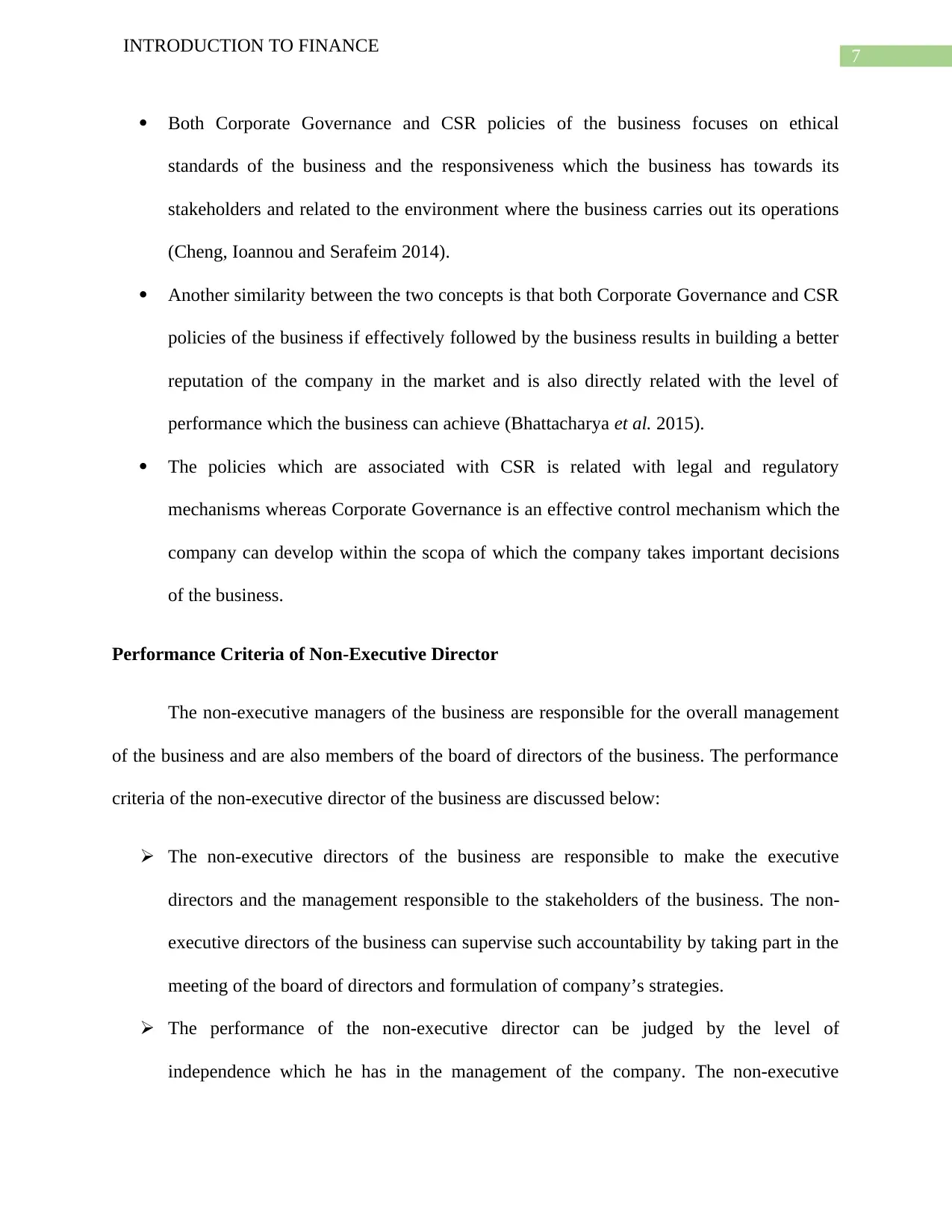
7
INTRODUCTION TO FINANCE
Both Corporate Governance and CSR policies of the business focuses on ethical
standards of the business and the responsiveness which the business has towards its
stakeholders and related to the environment where the business carries out its operations
(Cheng, Ioannou and Serafeim 2014).
Another similarity between the two concepts is that both Corporate Governance and CSR
policies of the business if effectively followed by the business results in building a better
reputation of the company in the market and is also directly related with the level of
performance which the business can achieve (Bhattacharya et al. 2015).
The policies which are associated with CSR is related with legal and regulatory
mechanisms whereas Corporate Governance is an effective control mechanism which the
company can develop within the scopa of which the company takes important decisions
of the business.
Performance Criteria of Non-Executive Director
The non-executive managers of the business are responsible for the overall management
of the business and are also members of the board of directors of the business. The performance
criteria of the non-executive director of the business are discussed below:
The non-executive directors of the business are responsible to make the executive
directors and the management responsible to the stakeholders of the business. The non-
executive directors of the business can supervise such accountability by taking part in the
meeting of the board of directors and formulation of company’s strategies.
The performance of the non-executive director can be judged by the level of
independence which he has in the management of the company. The non-executive
INTRODUCTION TO FINANCE
Both Corporate Governance and CSR policies of the business focuses on ethical
standards of the business and the responsiveness which the business has towards its
stakeholders and related to the environment where the business carries out its operations
(Cheng, Ioannou and Serafeim 2014).
Another similarity between the two concepts is that both Corporate Governance and CSR
policies of the business if effectively followed by the business results in building a better
reputation of the company in the market and is also directly related with the level of
performance which the business can achieve (Bhattacharya et al. 2015).
The policies which are associated with CSR is related with legal and regulatory
mechanisms whereas Corporate Governance is an effective control mechanism which the
company can develop within the scopa of which the company takes important decisions
of the business.
Performance Criteria of Non-Executive Director
The non-executive managers of the business are responsible for the overall management
of the business and are also members of the board of directors of the business. The performance
criteria of the non-executive director of the business are discussed below:
The non-executive directors of the business are responsible to make the executive
directors and the management responsible to the stakeholders of the business. The non-
executive directors of the business can supervise such accountability by taking part in the
meeting of the board of directors and formulation of company’s strategies.
The performance of the non-executive director can be judged by the level of
independence which he has in the management of the company. The non-executive
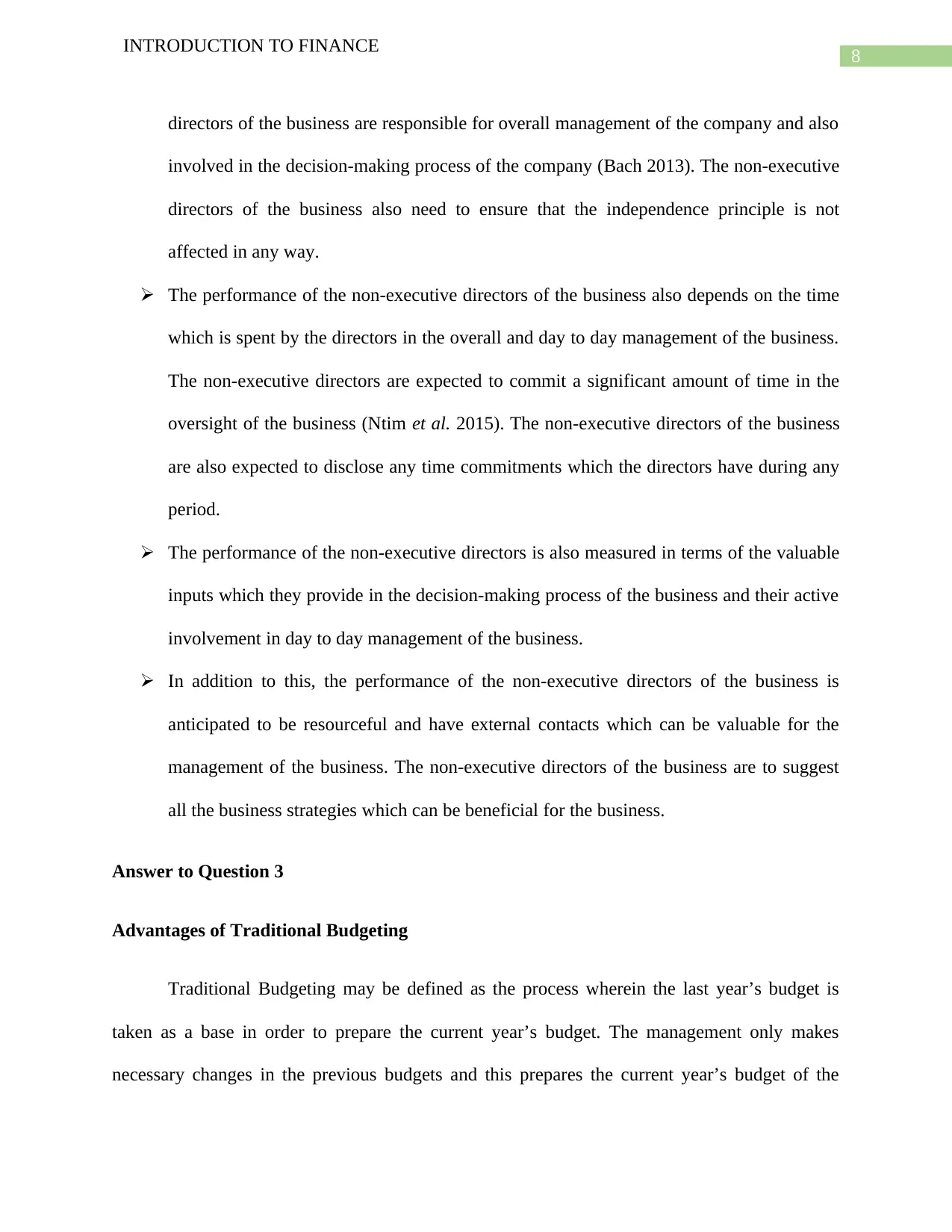
8
INTRODUCTION TO FINANCE
directors of the business are responsible for overall management of the company and also
involved in the decision-making process of the company (Bach 2013). The non-executive
directors of the business also need to ensure that the independence principle is not
affected in any way.
The performance of the non-executive directors of the business also depends on the time
which is spent by the directors in the overall and day to day management of the business.
The non-executive directors are expected to commit a significant amount of time in the
oversight of the business (Ntim et al. 2015). The non-executive directors of the business
are also expected to disclose any time commitments which the directors have during any
period.
The performance of the non-executive directors is also measured in terms of the valuable
inputs which they provide in the decision-making process of the business and their active
involvement in day to day management of the business.
In addition to this, the performance of the non-executive directors of the business is
anticipated to be resourceful and have external contacts which can be valuable for the
management of the business. The non-executive directors of the business are to suggest
all the business strategies which can be beneficial for the business.
Answer to Question 3
Advantages of Traditional Budgeting
Traditional Budgeting may be defined as the process wherein the last year’s budget is
taken as a base in order to prepare the current year’s budget. The management only makes
necessary changes in the previous budgets and this prepares the current year’s budget of the
INTRODUCTION TO FINANCE
directors of the business are responsible for overall management of the company and also
involved in the decision-making process of the company (Bach 2013). The non-executive
directors of the business also need to ensure that the independence principle is not
affected in any way.
The performance of the non-executive directors of the business also depends on the time
which is spent by the directors in the overall and day to day management of the business.
The non-executive directors are expected to commit a significant amount of time in the
oversight of the business (Ntim et al. 2015). The non-executive directors of the business
are also expected to disclose any time commitments which the directors have during any
period.
The performance of the non-executive directors is also measured in terms of the valuable
inputs which they provide in the decision-making process of the business and their active
involvement in day to day management of the business.
In addition to this, the performance of the non-executive directors of the business is
anticipated to be resourceful and have external contacts which can be valuable for the
management of the business. The non-executive directors of the business are to suggest
all the business strategies which can be beneficial for the business.
Answer to Question 3
Advantages of Traditional Budgeting
Traditional Budgeting may be defined as the process wherein the last year’s budget is
taken as a base in order to prepare the current year’s budget. The management only makes
necessary changes in the previous budgets and this prepares the current year’s budget of the
⊘ This is a preview!⊘
Do you want full access?
Subscribe today to unlock all pages.

Trusted by 1+ million students worldwide

9
INTRODUCTION TO FINANCE
business. For the preparation of such a budget the management considers factors such as
inflation rate, consumer demand and the present market situation (Réka, Ştefan and Daniel
2014).
The advantages which can be effectively pointed out for traditional budgets are explained
below in details:
Framework of Control: The most common advantage of any budgets is that it can be
used as a tool for exercising control over the business and also be used form
measuring the performance of the business. In other words traditional budgeting
forms a framework of control which can be help the management to promote
effectiveness of the management process and also manage the activities of the
business much easier and also promote stability.
Forms a part of the organizational Culture: The budgets which are prepared by the
management forms a part of the organizational culture of the business. Budgeting
practices are widely used in the business and also universally applicable to every
department of the company. Traditional Budgeting is still widely used in finance, cost
and operations department and forms a part of the regular activity of the business
(Sandalgaard and Nikolaj Bukh 2014).
Planning and Forecasting: Traditional Budgeting enables the business to forecast the
expenses and revenues which the business expects to generate during the year and
also facilitates comparison between the actuals results of the previous year (Dudin et
al. 2015). The budgets are considered to be important tools with the help of which the
management can exercise control and also measure the performance of the business.
INTRODUCTION TO FINANCE
business. For the preparation of such a budget the management considers factors such as
inflation rate, consumer demand and the present market situation (Réka, Ştefan and Daniel
2014).
The advantages which can be effectively pointed out for traditional budgets are explained
below in details:
Framework of Control: The most common advantage of any budgets is that it can be
used as a tool for exercising control over the business and also be used form
measuring the performance of the business. In other words traditional budgeting
forms a framework of control which can be help the management to promote
effectiveness of the management process and also manage the activities of the
business much easier and also promote stability.
Forms a part of the organizational Culture: The budgets which are prepared by the
management forms a part of the organizational culture of the business. Budgeting
practices are widely used in the business and also universally applicable to every
department of the company. Traditional Budgeting is still widely used in finance, cost
and operations department and forms a part of the regular activity of the business
(Sandalgaard and Nikolaj Bukh 2014).
Planning and Forecasting: Traditional Budgeting enables the business to forecast the
expenses and revenues which the business expects to generate during the year and
also facilitates comparison between the actuals results of the previous year (Dudin et
al. 2015). The budgets are considered to be important tools with the help of which the
management can exercise control and also measure the performance of the business.
Paraphrase This Document
Need a fresh take? Get an instant paraphrase of this document with our AI Paraphraser
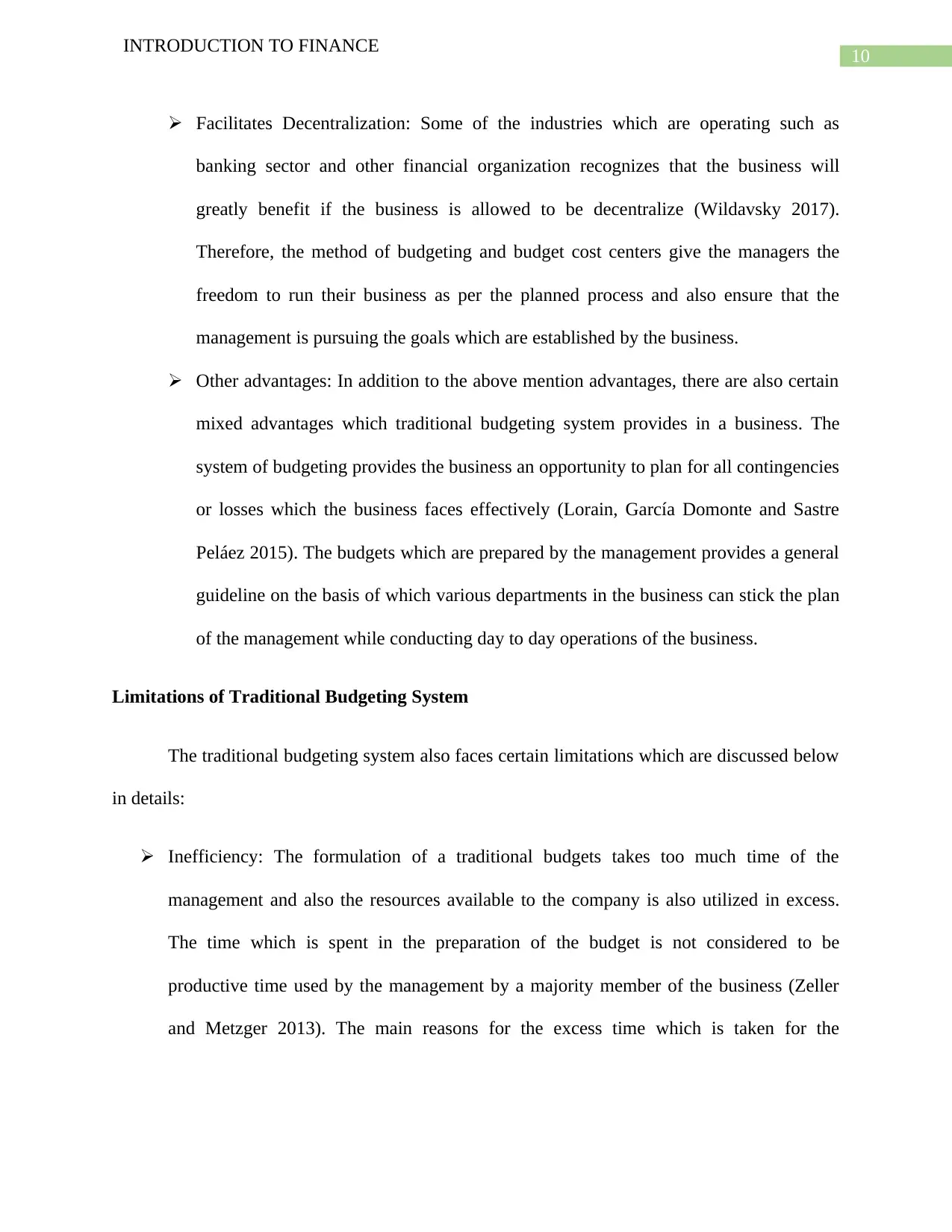
10
INTRODUCTION TO FINANCE
Facilitates Decentralization: Some of the industries which are operating such as
banking sector and other financial organization recognizes that the business will
greatly benefit if the business is allowed to be decentralize (Wildavsky 2017).
Therefore, the method of budgeting and budget cost centers give the managers the
freedom to run their business as per the planned process and also ensure that the
management is pursuing the goals which are established by the business.
Other advantages: In addition to the above mention advantages, there are also certain
mixed advantages which traditional budgeting system provides in a business. The
system of budgeting provides the business an opportunity to plan for all contingencies
or losses which the business faces effectively (Lorain, García Domonte and Sastre
Peláez 2015). The budgets which are prepared by the management provides a general
guideline on the basis of which various departments in the business can stick the plan
of the management while conducting day to day operations of the business.
Limitations of Traditional Budgeting System
The traditional budgeting system also faces certain limitations which are discussed below
in details:
Inefficiency: The formulation of a traditional budgets takes too much time of the
management and also the resources available to the company is also utilized in excess.
The time which is spent in the preparation of the budget is not considered to be
productive time used by the management by a majority member of the business (Zeller
and Metzger 2013). The main reasons for the excess time which is taken for the
INTRODUCTION TO FINANCE
Facilitates Decentralization: Some of the industries which are operating such as
banking sector and other financial organization recognizes that the business will
greatly benefit if the business is allowed to be decentralize (Wildavsky 2017).
Therefore, the method of budgeting and budget cost centers give the managers the
freedom to run their business as per the planned process and also ensure that the
management is pursuing the goals which are established by the business.
Other advantages: In addition to the above mention advantages, there are also certain
mixed advantages which traditional budgeting system provides in a business. The
system of budgeting provides the business an opportunity to plan for all contingencies
or losses which the business faces effectively (Lorain, García Domonte and Sastre
Peláez 2015). The budgets which are prepared by the management provides a general
guideline on the basis of which various departments in the business can stick the plan
of the management while conducting day to day operations of the business.
Limitations of Traditional Budgeting System
The traditional budgeting system also faces certain limitations which are discussed below
in details:
Inefficiency: The formulation of a traditional budgets takes too much time of the
management and also the resources available to the company is also utilized in excess.
The time which is spent in the preparation of the budget is not considered to be
productive time used by the management by a majority member of the business (Zeller
and Metzger 2013). The main reasons for the excess time which is taken for the
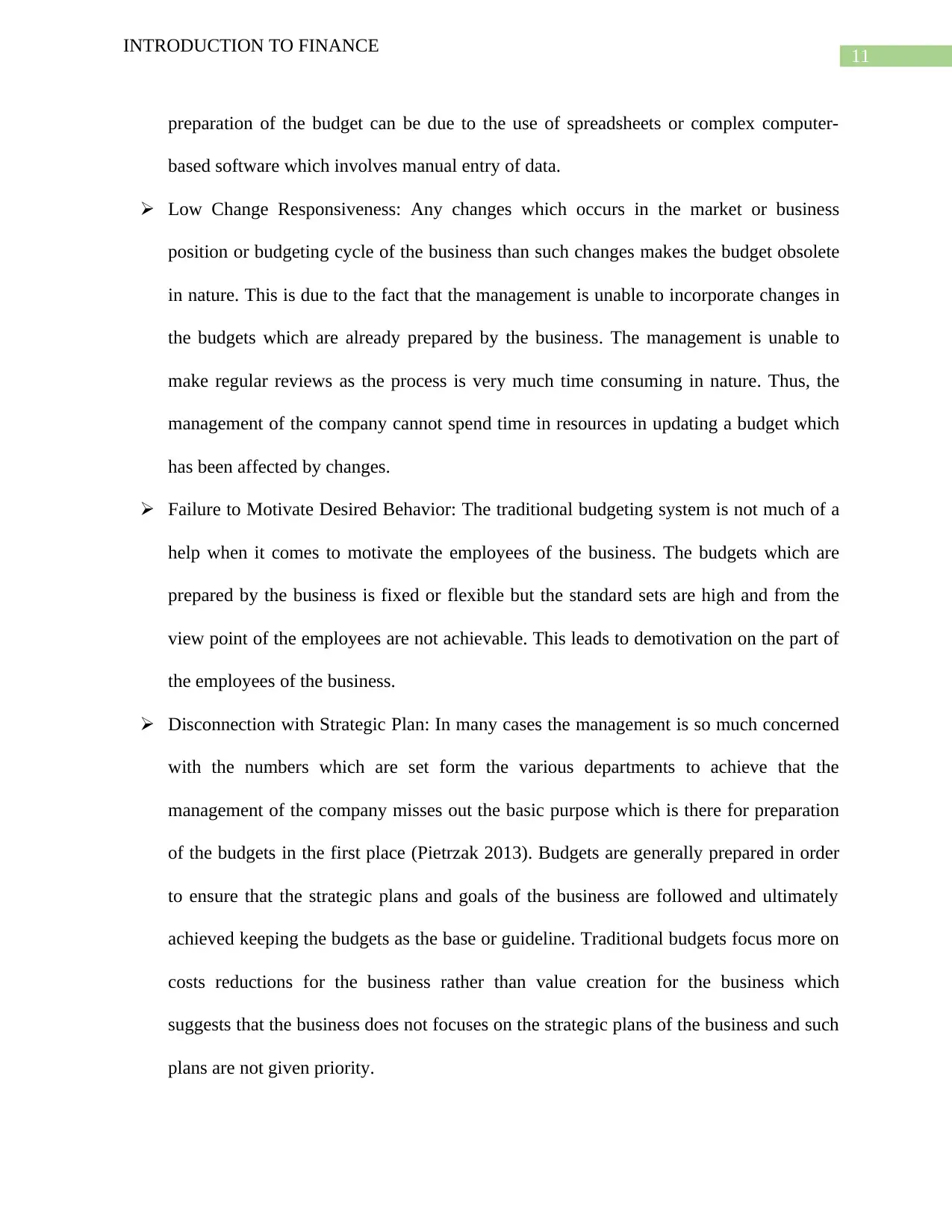
11
INTRODUCTION TO FINANCE
preparation of the budget can be due to the use of spreadsheets or complex computer-
based software which involves manual entry of data.
Low Change Responsiveness: Any changes which occurs in the market or business
position or budgeting cycle of the business than such changes makes the budget obsolete
in nature. This is due to the fact that the management is unable to incorporate changes in
the budgets which are already prepared by the business. The management is unable to
make regular reviews as the process is very much time consuming in nature. Thus, the
management of the company cannot spend time in resources in updating a budget which
has been affected by changes.
Failure to Motivate Desired Behavior: The traditional budgeting system is not much of a
help when it comes to motivate the employees of the business. The budgets which are
prepared by the business is fixed or flexible but the standard sets are high and from the
view point of the employees are not achievable. This leads to demotivation on the part of
the employees of the business.
Disconnection with Strategic Plan: In many cases the management is so much concerned
with the numbers which are set form the various departments to achieve that the
management of the company misses out the basic purpose which is there for preparation
of the budgets in the first place (Pietrzak 2013). Budgets are generally prepared in order
to ensure that the strategic plans and goals of the business are followed and ultimately
achieved keeping the budgets as the base or guideline. Traditional budgets focus more on
costs reductions for the business rather than value creation for the business which
suggests that the business does not focuses on the strategic plans of the business and such
plans are not given priority.
INTRODUCTION TO FINANCE
preparation of the budget can be due to the use of spreadsheets or complex computer-
based software which involves manual entry of data.
Low Change Responsiveness: Any changes which occurs in the market or business
position or budgeting cycle of the business than such changes makes the budget obsolete
in nature. This is due to the fact that the management is unable to incorporate changes in
the budgets which are already prepared by the business. The management is unable to
make regular reviews as the process is very much time consuming in nature. Thus, the
management of the company cannot spend time in resources in updating a budget which
has been affected by changes.
Failure to Motivate Desired Behavior: The traditional budgeting system is not much of a
help when it comes to motivate the employees of the business. The budgets which are
prepared by the business is fixed or flexible but the standard sets are high and from the
view point of the employees are not achievable. This leads to demotivation on the part of
the employees of the business.
Disconnection with Strategic Plan: In many cases the management is so much concerned
with the numbers which are set form the various departments to achieve that the
management of the company misses out the basic purpose which is there for preparation
of the budgets in the first place (Pietrzak 2013). Budgets are generally prepared in order
to ensure that the strategic plans and goals of the business are followed and ultimately
achieved keeping the budgets as the base or guideline. Traditional budgets focus more on
costs reductions for the business rather than value creation for the business which
suggests that the business does not focuses on the strategic plans of the business and such
plans are not given priority.
⊘ This is a preview!⊘
Do you want full access?
Subscribe today to unlock all pages.

Trusted by 1+ million students worldwide
1 out of 15
Related Documents
Your All-in-One AI-Powered Toolkit for Academic Success.
+13062052269
info@desklib.com
Available 24*7 on WhatsApp / Email
![[object Object]](/_next/static/media/star-bottom.7253800d.svg)
Unlock your academic potential
Copyright © 2020–2025 A2Z Services. All Rights Reserved. Developed and managed by ZUCOL.




